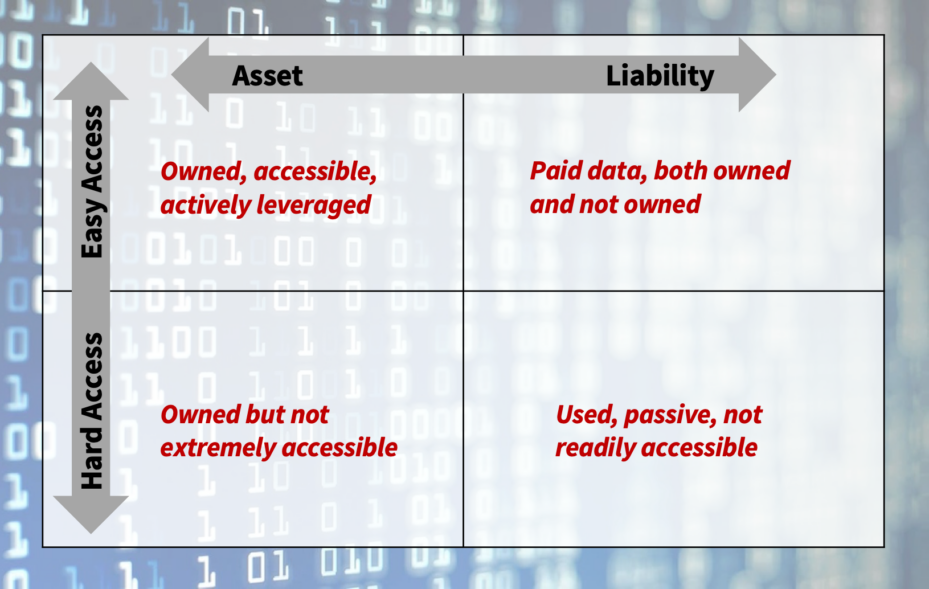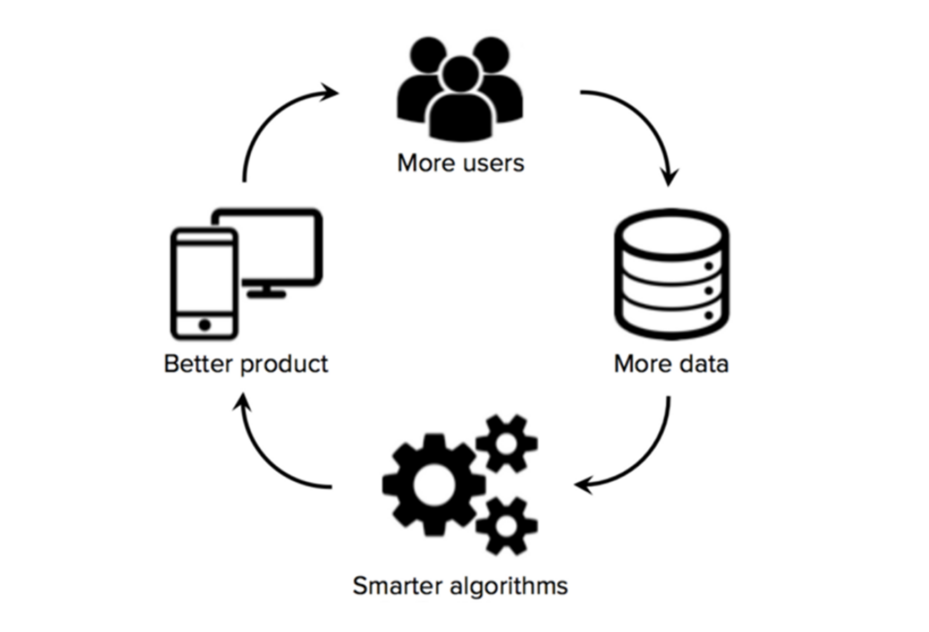The following article was written by Scott Snyder, a senior fellow at Wharton’s Mack Institute for Innovation Management and Chief Digital Officer at EVERSANA.
Given the uncertain and volatile nature of markets today, having a strong financial balance sheet is critical to surviving and thriving as new opportunities emerge. But what about your company’s data balance sheet?
In a digital-first world, data is the “oxygen” or “currency” you need to fuel digital innovation, create impactful customer experiences, gain operational efficiencies, and attract the next wave of innovation partners to your company’s ecosystem. Every company is now a data company, whether they realize it or not. Ninety percent of company value lies in intangible assets, with data being one of the primary intangible assets. United Airlines’ frequent flier program was recently valued at $20B, higher than the current market cap of $14.5B. Some of the most valuable companies in the world, such as Amazon, Google, Microsoft, and Meta, are fundamentally data companies at their core. Other companies have used data coupled with AI to transform their business model, like Netflix moving from streaming to targeted content production and John Deere moving from selling farm equipment to selling precision agricultural insights as a service.
Despite the fact that 80% of all data will be controlled by enterprises by 2025, 40–90% of this data goes unused, or is “dark,” depending on the industry. With all this potential future value at stake, how well are you leveraging your organization’s data assets and managing your data liabilities?
Building Your Data Balance Sheet
The data balance sheet provides a simple framework to classify and visualize the key data assets in your organization to better assess how well you are unlocking the value of your current data as well as building and adding to your data advantage. This data can include customer data such as purchase habits or channel preferences, operational data such as processing time or defect rate, employee data such as compensation or attrition rate, transaction data such as conversion rates or purchases by region, and market data such as competitor activities or brand social mentions.
Figure 1 below shows a basic data balance sheet template with the left half being assets (data that is owned by your organization) and the right half being liabilities (data owned by others where you need to purchase or negotiate rights of use). The top half represents data that is easy to access by users across the organization whereas the bottom half is data where access is difficult or limited to a few users in the company. Let’s examine the opportunities and challenges that exist in more effectively capturing the value of data in each quadrant.

Easy-to-Access Data Assets. Data in this quadrant is owned by the company and is widely available by data users and innovators across the company. It might include customer, financial, and operational data that can be accessed via enterprise systems or data stores. But it is not always in a format or interface that makes it easy to leverage in building new applications or models. Ideally, data in this quadrant follows the FAIR principle — Findable, Accessible, Interoperable, and Re-usable — so that anyone in the company can use it to drive operational efficiencies or better customer experiences. This quadrant presents an immediate opportunity for continuous innovation in most companies, such as predictive maintenance, order-to-cash optimization, website personalization, or employee training and development. To tap into this opportunity, companies must improve data literacy and expand data analytics capabilities across the company; publish a data catalog of available data assets, data stewards, and associated policies governing their use; run “datathons” to jumpstart employee innovations with existing data assets; and create KPIs and incentives for leaders and teams tied to data innovation.
Hard-to-Access Data Assets. This quadrant is where the 40–90% of data assets that are “dark” exist. They may be locked away in organizational silos, disconnected or legacy IT platforms, or are walled off by legal or compliance restrictions. In many cases, this can be some of the most valuable data in the company, such as insights from R&D/innovation programs, deep customer insights within a business unit or brand, M&A due diligence data on potential and previous acquisitions, and operating or market data from other geographies and subsidiaries. When opportunities arise to innovate with data assets in this quadrant, the organizational friction tends to be high, with more people that say “no” than “yes.” But this also represents a great opportunity for leaders to challenge the reasons for restricting access to this data and find ways to innovate through them. This may include using privacy-enhancing technologies (PETs) such as differential privacy or federated AI to leverage deep user data to create new predictive models while protecting individual identities.
“Every company is now a data company, whether they realize it or not.”
Easy-to-Access Data Liabilities. This quadrant is where most of the paid data lives, such as market and customer research, environmental data like weather, and operational benchmarking. It is also where companies can look for data waste (paying for underleveraged data) and opportunities to capture these data assets through internal research efforts or direct customer and partner engagement. An example could be including micro-surveys along your current customer experience journey to capture direct feedback versus paying for third-party customer insights, or sharing data with value chain partners on operational/supply chain performance to identify efficiency opportunities versus paying for benchmarking data. It’s estimated that in the manufacturing sector alone, $100B in efficiencies would be captured through data-sharing across players. The goal is to move more of these data liabilities to assets or get more bang for the buck out of the data you are already paying for.
Hard-to-Access Data Liabilities. This quadrant may present both the biggest challenges and opportunities to capture value from data-driven innovations. Much of the data in this quadrant is hard to get to for a reason. It may be owned by a competitor or one of your main customers, which you would need to be granted permission to access. It could also be locked up in the IP of one of your key vendors that is unwilling to open the “black box” in the case of AI algorithms and the underlying training data. This is where real innovation is required to overcome these hurdles starting by asking a few key questions: What would it take to generate this data ourselves? Could we get our customers or even their end customers to participate in generating this type of data? Could we create a new data-sharing ecosystem or cooperative to build a collective data asset with similar or greater value to all participants? Seventy-one percent of executives expect the volume of data exchanged via ecosystems to increase. Examples like Otonomo in automotive, UP42 in satellite imagery, and MELLODDY in life sciences R&D will become more than the norm as companies see the need to integrate data assets across many players to apply AI to higher-impact opportunities.
Building a Perpetual Data Advantage
As you map out and evaluate your data balance sheet, some of the opportunities to capture more value from data will be obvious while others will require more transformational efforts.
How can you make sure your data innovation efforts won’t fizzle out?
- Use the data balance sheet to highlight missed opportunities with existing data assets and data waste for purchased data assets. Assign values to these misses to create the compelling business rationale to move on data innovation opportunities.
- Move on quick wins across the organization by leveraging existing data assets to drive near-term improvements in operational efficiencies or customer experience with tangible payback. This will create momentum and interest in pursuing bigger-ticket opportunities on the liability side of the balance sheet.
- Look for opportunities to build “data flywheels” by engaging customers and ecosystem partners with products, services, and experiences that deliver clear benefit and drive additional engagement, data, and insights that lead to smarter algorithms and even better products, services, and experiences the next time — as shown in Figure 2. This creates a perpetual data advantage and offers the opportunity to directly capture “zero party” data where customers willingly volunteer their data to your company in return for clear benefit.

Remember: Your company is a data company. Building a data advantage is critical to your future success. Now is the time to strengthen your data balance sheet and unlock the full value of one of your most valuable assets.

